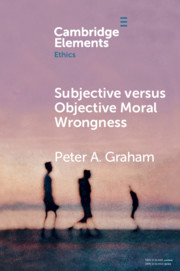335 results
Optimal performance of a tontine overlay subject to withdrawal constraints
-
- Journal:
- ASTIN Bulletin: The Journal of the IAA / Volume 54 / Issue 1 / January 2024
- Published online by Cambridge University Press:
- 17 November 2023, pp. 94-128
- Print publication:
- January 2024
-
- Article
-
- You have access
- Open access
- HTML
- Export citation
3 - Must we turn the trolley?
-
-
- Book:
- The Trolley Problem
- Published online:
- 24 February 2023
- Print publication:
- 02 March 2023, pp 42-58
-
- Chapter
- Export citation
Expanding mental health services in low- and middle-income countries: A task-shifting framework for delivery of comprehensive, collaborative, and community-based care
-
- Journal:
- Cambridge Prisms: Global Mental Health / Volume 10 / 2023
- Published online by Cambridge University Press:
- 27 February 2023, e16
-
- Article
-
- You have access
- Open access
- HTML
- Export citation
Moral identity in psychopathy
-
- Journal:
- Judgment and Decision Making / Volume 5 / Issue 7 / December 2010
- Published online by Cambridge University Press:
- 01 January 2023, pp. 497-505
-
- Article
-
- You have access
- Open access
- HTML
- Export citation
Multicentre randomised controlled trial of a group psychological intervention for postnatal depression in British mothers of South Asian origin (ROSHNI-2): study protocol
-
- Journal:
- BJPsych Open / Volume 8 / Issue 1 / January 2022
- Published online by Cambridge University Press:
- 01 December 2021, e2
-
- Article
-
- You have access
- Open access
- HTML
- Export citation
Developing Higher Quality Conductors and Insulators to Enable Fieldable FIB edits to Complex Microelectronics
-
- Journal:
- Microscopy and Microanalysis / Volume 27 / Issue S1 / August 2021
- Published online by Cambridge University Press:
- 30 July 2021, p. 212
- Print publication:
- August 2021
-
- Article
-
- You have access
- Export citation
OPTIMAL CONTROL OF THE DECUMULATION OF A RETIREMENT PORTFOLIO WITH VARIABLE SPENDING AND DYNAMIC ASSET ALLOCATION
- Part of
-
- Journal:
- ASTIN Bulletin: The Journal of the IAA / Volume 51 / Issue 3 / September 2021
- Published online by Cambridge University Press:
- 28 July 2021, pp. 905-938
- Print publication:
- September 2021
-
- Article
- Export citation
Factors in psychiatric admissions: before and during the COVID-19 pandemic
-
- Journal:
- BJPsych Open / Volume 7 / Issue S1 / June 2021
- Published online by Cambridge University Press:
- 18 June 2021, p. S40
-
- Article
-
- You have access
- Open access
- Export citation

Subjective versus Objective Moral Wrongness
-
- Published online:
- 20 March 2021
- Print publication:
- 15 April 2021
-
- Element
- Export citation
Chapter 4 - What Is Epistemic Entitlement?
-
-
- Book:
- Virtue Theoretic Epistemology
- Published online:
- 16 July 2020
- Print publication:
- 23 July 2020, pp 93-123
-
- Chapter
- Export citation
Jumping to conclusions, general intelligence, and psychosis liability: findings from the multi-centre EU-GEI case-control study
-
- Journal:
- Psychological Medicine / Volume 51 / Issue 4 / March 2021
- Published online by Cambridge University Press:
- 24 April 2020, pp. 623-633
-
- Article
-
- You have access
- Open access
- HTML
- Export citation
OPTIMAL ASSET ALLOCATION FOR DC PENSION DECUMULATION WITH A VARIABLE SPENDING RULE
-
- Journal:
- ASTIN Bulletin: The Journal of the IAA / Volume 50 / Issue 2 / May 2020
- Published online by Cambridge University Press:
- 15 April 2020, pp. 419-447
- Print publication:
- May 2020
-
- Article
- Export citation
Does Justification Aim at Truth?
-
- Journal:
- Canadian Journal of Philosophy / Volume 41 / Issue 1 / March 2011
- Published online by Cambridge University Press:
- 01 January 2020, pp. 51-71
-
- Article
- Export citation
Clustered or dispersed: testing the effect of sampling strategy to census burrow-nesting petrels with varied distributions at sub-Antarctic Marion Island
-
- Journal:
- Antarctic Science / Volume 31 / Issue 5 / October 2019
- Published online by Cambridge University Press:
- 28 August 2019, pp. 231-242
-
- Article
- Export citation
Dedication
-
- Book:
- An Introduction to Radio Astronomy
- Published online:
- 06 August 2019
- Print publication:
- 22 August 2019, pp v-vi
-
- Chapter
- Export citation
Index
-
- Book:
- An Introduction to Radio Astronomy
- Published online:
- 06 August 2019
- Print publication:
- 22 August 2019, pp 517-524
-
- Chapter
- Export citation
11 - Further Interferometric Techniques
- from Part II - Radio Telescopes and Aperture Synthesis
-
- Book:
- An Introduction to Radio Astronomy
- Published online:
- 06 August 2019
- Print publication:
- 22 August 2019, pp 266-298
-
- Chapter
- Export citation
Preface
-
- Book:
- An Introduction to Radio Astronomy
- Published online:
- 06 August 2019
- Print publication:
- 22 August 2019, pp xvii-xx
-
- Chapter
- Export citation
References
-
- Book:
- An Introduction to Radio Astronomy
- Published online:
- 06 August 2019
- Print publication:
- 22 August 2019, pp 493-516
-
- Chapter
- Export citation

